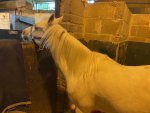Red-1
I used to be decisive, now I'm not so sure...
L94 helped mine too. I put him on it when he went sore.
He looked fabulous after 1 bottle, but a few weeks later needed a second. Been fine since.
I have found that Metaslim helps keep weight off. I also feed a second net of straw for a full tummy with few calories, and well soaked hay. He now can have a few hours out, muzzled.
The vet was insistent that he was skinny, and he now does not blood test as EMS, even though he defo was before.
It is a bit disconcerting, seeing ribs, but then, you can see mine too and they don't hurt!
He looked fabulous after 1 bottle, but a few weeks later needed a second. Been fine since.
I have found that Metaslim helps keep weight off. I also feed a second net of straw for a full tummy with few calories, and well soaked hay. He now can have a few hours out, muzzled.
The vet was insistent that he was skinny, and he now does not blood test as EMS, even though he defo was before.
It is a bit disconcerting, seeing ribs, but then, you can see mine too and they don't hurt!


